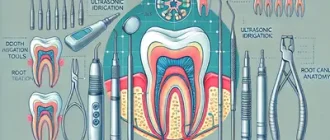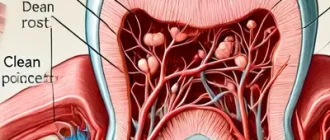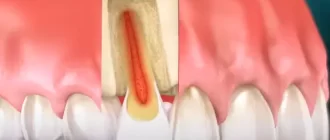Root canal filling – this method is used in dentistry to treat dental diseases such as pulpitis or periodontitis.
What is a root canal?
Anatomically, a tooth consists of a crown and a root. The crown of the tooth is the part that is above the gum, while the root is in the jawbone. The neurovascular bundle enters the tooth at the very tip of its root or roots. From the point of entry of the nerve to the pulp chamber (the cavity that is in the center of the tooth) along the length of the tooth, narrow canals run – these are the root canals of the tooth.
See also: Tooth Surgery After Root Canal
Why treat root canals?
The pulp (the nerve), like any organ, reacts with inflammation in response to irritation.
The main cause of inflammation of the nerve tissue of the tooth is carious lesion. As the carious process progresses and the enamel deteriorates, bacteria penetrate the dentin. Deep decay damage that reaches the dentin gives the bacteria an opportunity to penetrate the pulp of the tooth and cause pulp inflammation.
Once inside the tooth, the bacteria begin to multiply actively. This disrupts the normal functioning of the tooth and causes discomfort or pain to the wearer.
The body itself can not solve this problem, because the bacteria not only destroy the tooth, but also destroy its defense system: the blood vessels are no longer able to deliver to the lesion special defense cells that can fight infection. Such a diseased nerve must be got rid of.
Good to know: Average Cost of Root Canal Treatment in US
Root canal treatment goals
Endodontic therapy is largely a root canal cleaning procedure (the part originally occupied by nerve tissue). Root canal cleaning is done to eliminate the bacteria that have accumulated in it. This accomplishes three goals:
- eliminating the bacteria that have accumulated inside the tooth;
- nerve tissue and all other organic debris is removed
- the space of the dental nerve is filled and sealed.
See also: Toothache After a Root Canal Cleaning
Stages of endodontic therapy
Endodontic therapy consists of the following steps: anesthesia, isolation of the tooth from oral fluid, providing access to the pulp area, root canal cleaning, and root canal filling.
Tooth anesthesia
Root canal treatment has had an unimportant reputation as being very painful. But this is completely wrong, because in modern dentistry there is a concept of “treatment without pain”, which is well worth it. Root canal treatment is a completely painless procedure, no different from tooth filling.
Prior to root canal treatment, anesthesia is administered. In order to ensure that the patient does not experience discomfort associated with the injection during anesthesia, a high concentration of anesthetic solution (anesthetic) is smeared on the place where the needle is inserted, anesthetic gel is applied. The process of anesthesia itself is anesthetized.
Providing access to the root canal area
Before beginning root canal cleaning, the dentist must provide good access to the root canal area. To get good access to the pulp area, the dental drill creates a straight cavity leading to the root canals. Younger patients have greater access because their pulp chamber is larger. And the teeth of older patients have a smaller dental cavity, so less preparation is required.
Access on the anterior teeth is done on their posterior side, on the posterior teeth – on the chewing surface.
Do You Know What Is the Most Painful Dental Procedure?
Root canal preparation (cleaning)
Root canal cleaning includes mechanical and medicinal treatment (we know that many bacteria accumulate in the root canals). At the stage of root canal cleaning it is important to remove bacteria, pulp tissue.
Mechanical treatment of root canals is done with special instruments, which in dentistry are called files.
These tools are very similar to straight needles, they have a certain length, size, taper, rough surface resembling a saw. The dentist treats the root canals with a set of these files, making up-and-down movements through the canals of the tooth while making rotary movements with them.
The dentist performs the disinfection by irrigating the root canals with special disposable needles.
Treatment with files is performed along the entire length of the root canal to the apex of the root, but not beyond the apex. The main step in the treatment of root canals is to determine their length. To do this, the dentist first inserts the files into the canals and takes an X-ray, by which the root canal length is determined.
After the root canals are thoroughly cleaned, the dentist can begin to fill the canals.
Read also: Tooth Cavity Filling: Cost and Step-by-Step Procedure
Root canal filling
The success of root canal filling is largely determined by the quality of previous endodontic manipulations, and mainly determines the outcome of the treatment.
The main requirement for this stage is a reliable sealing of root canals. Before the filling the root canals are dried with paper pins.
To fill the root canals gutta-percha and paste are used. Gutta-percha is a rubber material that is produced in the form of cones, the size and shape of gutta-percha correspond to the shape and size of the files, which are used to clean the root canals.
Gutta-percha cones are coated with paste and inserted into the root canals of the tooth. In order to obtain a good seal, several more cones are inserted into the root canals.
The canal must be filled to the apex without voids or defects.
After all of this, the next visit is scheduled, during which the dentist places a permanent filling.
Dental Pins
Root pins (known in dentistry as anchor pins) are rods made of titanium. They are inserted and anchored only in those teeth that have lost a significant amount of hard tissue.
To install the pin, the dentist removes some gutta-percha (with which the root canal has been filled) to obtain a place for the pin.
The pin is then cemented into the root canal, and then a filling material is placed on top of it to restore the anatomical shape of the tooth.
In this way, the use of pins strengthens a tooth that has been stripped of a large amount of hard tissue.
Restoring teeth after endodontic therapy
Once the root canal treatment is complete, the dentist decides on the restoration of the tooth. Tooth restoration after endodontic therapy is done in several ways:
- Filling with composite materials (matching the color of the tooth)
- Filling with composite materials and posts
- Using crowns.
The fact is that in many cases during endodontic treatment, the tooth is deprived of quite a significant amount of dental tissue. Teeth in such condition become fragile, and the dentist will have to address the issue of adequate dental restoration.






